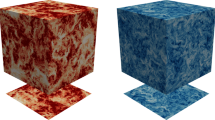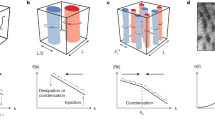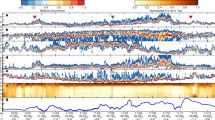Abstract
Astrophysical magnetic fields often display remarkable organization, despite being generated by dynamo action driven by turbulent flows at high conductivity1,2. An example is the eleven-year solar cycle, which shows spatial coherence over the entire solar surface3,4,5. The difficulty in understanding the emergence of this large-scale organization is that whereas at low conductivity (measured by the magnetic Reynolds number, Rm) dynamo fields are well organized, at high Rm their structure is dominated by rapidly varying small-scale fluctuations. This arises because the smallest scales have the highest rate of strain, and can amplify magnetic field most efficiently. Therefore most of the effort to find flows whose large-scale dynamo properties persist at high Rm has been frustrated. Here we report high-resolution simulations of a dynamo that can generate organized fields at high Rm; indeed, the generation mechanism, which involves the interaction between helical flows and shear, only becomes effective at large Rm. The shear does not enhance generation at large scales, as is commonly thought; instead it reduces generation at small scales. The solution consists of propagating dynamo waves, whose existence was postulated more than 60 years ago6 and which have since been used to model the solar cycle7.
This is a preview of subscription content, access via your institution
Access options
Subscribe to this journal
Receive 51 print issues and online access
$199.00 per year
only $3.90 per issue
Buy this article
- Purchase on Springer Link
- Instant access to full article PDF
Prices may be subject to local taxes which are calculated during checkout




Similar content being viewed by others
References
Parker, E. N. Cosmical Magnetic Fields: Their Origin and Their Activity (Clarendon, 1979)
Moffatt, H. K. Magnetic Field Generation in Electrically Conducting Fluids (Cambridge Univ. Press, 1978)
Mestel, L. Stellar Magnetism (Clarendon, 1999)
Tobias, S. M. The solar dynamo. Phil. Trans. R. Soc. Lond. A 360, 2741–2756 (2002)
Stix, M. The Sun: An Introduction (Springer, 2004)
Parker, E. N. Hydromagnetic dynamo models. Astrophys. J. 122, 293–314 (1955)
Tobias, S. & Weiss, N. in The Solar Tachocline (eds Hughes, D. W., Rosner, R. & Weiss, N. O. ) 319–350 (Cambridge University Press, 2007)
Steenbeck, M., Krause, F. & Rädler, K.-H. Berechnung der mittleren LORENTZ-Feldstärke für ein elektrisch leitendes Medium in turbulenter, durch CORIOLIS-Kräfte beeinflußter Bewegung. Z. Naturforsch. A 21, 369–376 (1966)
Yousef, T. A. et al. Generation of magnetic field by combined action of turbulence and shear. Phys. Rev. Lett. 100, 184501 (2008)
Käpylä, P. J. & Brandenburg, A. Turbulent dynamos with shear and fractional helicity. Astrophys. J. 699, 1059–1066 (2009)
Sridhar, S. & Singh, N. K. The shear dynamo problem for small magnetic Reynolds numbers. J. Fluid Mech. 664, 265–285 (2010)
Hughes, D. W. & Proctor, M. R. E. The effect of velocity shear on dynamo action due to rotating convection. J. Fluid Mech. 717, 395–416 (2013)
Galloway, D. J. & Proctor, M. R. E. Numerical calculations of fast dynamos in smooth velocity fields with realistic diffusion. Nature 356, 691–693 (1992)
Tobias, S. M. & Cattaneo, F. Dynamo action in complex flows: the quick and the fast. J. Fluid Mech. 601, 101–122 (2008)
Finn, J. M. & Ott, E. Chaotic flows and fast magnetic dynamos. Phys. Fluids 31, 2992–3011 (1988)
Courvoisier, A. & Kim, E.-J. Kinematic α effect in the presence of a large-scale motion. Phys. Rev. E 80, 046308 (2009)
Cattaneo, F. & Tobias, S. M. Interaction between dynamos at different scales. Phys. Fluids 17, 127105 (2005)
Courvoisier, A., Hughes, D. W. & Tobias, S. M. α Effect in a family of chaotic flows. Phys. Rev. Lett. 96, 034503 (2006)
Acknowledgements
This work was supported in part by the Science and Technology Facilities Council (STFC) and by the Center for Magnetic Self-Organisation (sponsored by the National Science Foundation) at the University of Chicago. Computations were performed on the STFC-supported UKMHD consortium cluster (DiRAC) at the University of Leeds.
Author information
Authors and Affiliations
Contributions
The authors contributed equally to all aspects (theoretical and numerical) of the paper.
Corresponding author
Ethics declarations
Competing interests
The authors declare no competing financial interests.
Supplementary information
Supplementary Information
This file contains Supplementary Text and Data. (PDF 64 kb)
Rights and permissions
About this article
Cite this article
Tobias, S., Cattaneo, F. Shear-driven dynamo waves at high magnetic Reynolds number. Nature 497, 463–465 (2013). https://doi.org/10.1038/nature12177
Received:
Accepted:
Published:
Issue Date:
DOI: https://doi.org/10.1038/nature12177
This article is cited by
-
Numerical evidence for a small-scale dynamo approaching solar magnetic Prandtl numbers
Nature Astronomy (2023)
-
Magnetism, dynamo action and the solar-stellar connection
Living Reviews in Solar Physics (2017)
-
A Remarkable Recent Transition in the Solar Dynamo
Space Science Reviews (2016)
-
Electric Current Circuits in Astrophysics
Space Science Reviews (2015)
-
Shear drop
Nature Physics (2013)
Comments
By submitting a comment you agree to abide by our Terms and Community Guidelines. If you find something abusive or that does not comply with our terms or guidelines please flag it as inappropriate.



